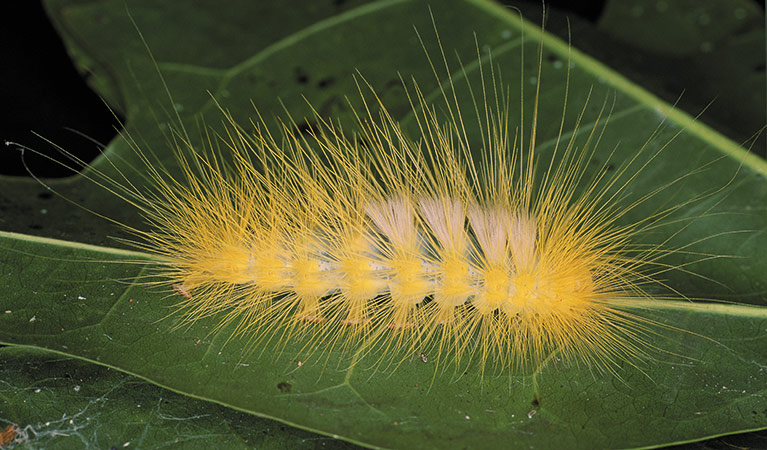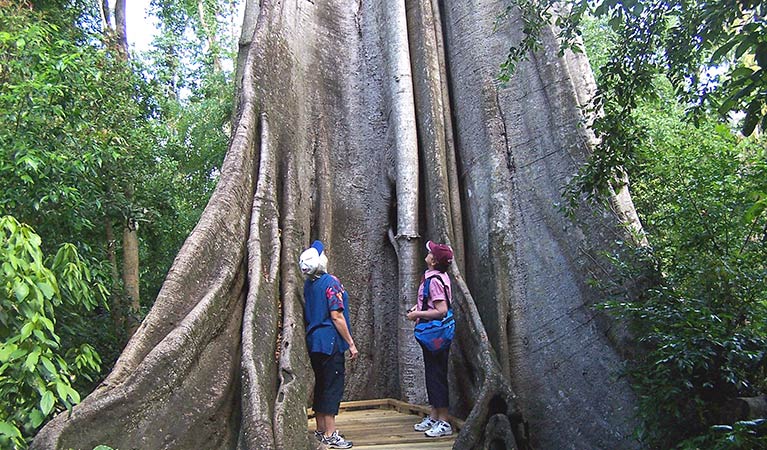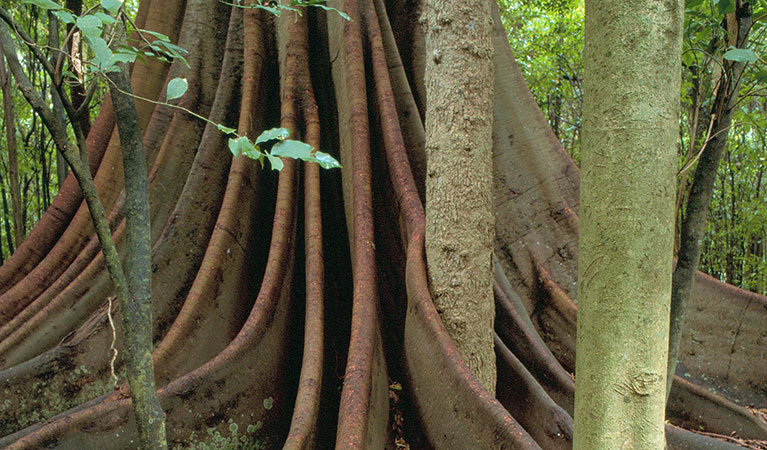Wingham Brush boardwalk
Wingham Brush Nature Reserve
Overview
Wingham Brush boardwalk connects several walking tracks for a wheelchair friendly experience in the rainforest. Enjoy birdwatching and see a grey-headed flying fox roosting site.
- Where
- Wingham Brush Nature Reserve in North Coast
- Accessibility
- Easy
- Distance
- 1.9km return
- Time suggested
- 30 - 45min
- Grade
- Grade 2
- What to
bring - Hat, sunscreen, binoculars
- Please note
- The roosting site can be noisy, smelly, and messy with flying-fox droppings. It's a good idea to keep your mouth closed and wear glasses when looking up at the flying-foxes.
- Try not to make too much noise at the roosting site as it disturbs these protected mammals and can effect their breeding effectiveness.
Wingham Brush boardwalk is a gateway to the incredible world of plants, birds and threatened grey-headed flying foxes in the rainforest. Set out from the carpark at the end of Farquhar Street, along Graham Allen walking track. The wheelchair-friendly boardwalk is raised above the forest floor to protect this Threatened Ecological Community (TEC).
You'll soon connect with Flying Fox circuit, where you’ll find yourself standing directly under a flying foxes' roosting site. Learn about the plants and animals that live here from the informative signage along the way, or just admire the gigantic Moreton Bay fig, stinging, and white cedar trees.
From here, you can loop back to your start point, or continue west along Graham Allen walking track to meet Regenerators walk. Keep your eyes out for land mullets and brush turkeys in the undergrowth and listen for the distinct calls of the green catbird and wompoo fruit-dove.
Why not pack a picnic, make a day of it and enjoy picnicking, swimming and fishing at nearby Wingham River Park? Then, sit by the banks of the river and watch the flying foxes flying out at sunset.
Map

Map legend

Local alerts
For the latest updates on fires, closures and other alerts in this area, see https://uat.nswparks.cloud/things-to-do/walking-tracks/wingham-brush-boardwalk/local-alerts
General enquiries
- National Parks Contact Centre
- 7am to 7pm daily
- 1300 072 757 (13000 PARKS) for the cost of a local call within Australia excluding mobiles
- parks.info@environment.nsw.gov.au
Park info
- in Wingham Brush Nature Reserve in the North Coast region
Wingham Brush Nature Reserve is always open but may have to close at times due to poor weather, flooding, or for the benefit of the flying foxes during breeding.
Visitor info
All the practical information you need to know about Wingham Brush boardwalk.
Maps and downloads
Learn more
Wingham Brush boardwalk is in Wingham Brush Nature Reserve. Here are just some of the reasons why this park is special:
Biripi country

Wingham Brush is part of the traditional lands of the Biripi people. Prior to European occupation, the Biripi people used the area to collect bush tucker, medicinal plants, and for social gatherings by the river. 'Wingan' in the local Aboriginal language means 'where bats come to drink'. Sit by the banks of the river and you might see bats and flying foxes diving into the river to quench their thirst.
Friendly flying foxes

Wingham Brush is the only known continuously occupied roosting and maternity site for the vulnerable grey-headed flying fox between Bellingen and the Hunter Valley, peaking at over 200,000 flying foxes in the warmer months. They roost by day and fly out at night to feed. Guided in the dark by excellent eyesight and sense of smell, they forage for up to 40km from their roost. Sit by the banks of the river at sunset and you'll see this spectacular sight as they fly out in search of food. Fans of other flying things will love bird watching here too You'll find over 100 bird species here, including the osprey, black-necked stork or jabiru and wompoo fruit-dove.
- Grey-headed flying-fox live cam Get a glimpse into the world of threatened grey-headed flying-foxes at Wingham Brush Nature Reserve. Watch our bat cam live stream any time from dawn to dusk.
- Junior ranger: Wingham Brush wildlife walk Walk alongside a NPWS Discovery Ranger and explore a vibrant life under the canopy of subtropical rainforest at Wingham Brush Nature Reserve.
- Wingham Brush boardwalk Wingham Brush boardwalk connects several walking tracks for a wheelchair friendly experience in the rainforest. Enjoy birdwatching and see a grey-headed flying fox roosting site.
- Wingham Brush twilight tour Experience the magic of Wingham Brush Nature Reserve at twilight. Soak in breathtaking scenery as we meander along the boardwalk while the sun sets over a canopy of flying foxes.
The Wingham Brush method

Wingham Brush was once pristine rainforest but under European settlement, the area was selectively logged, especially for red cedar. You can still see the remains of two saw pits today from the mid-1800s. Fortunately, in 1909, it became a reserve, with the historic wharf on Manning River. But by 1980, the rainforest was infested with weeds, which threatened its very survival. Thanks to the dedication of the Wingham Brush regeneration team, and what is now internationally recognised as 'The Wingham Brush method', the rainforest has since been regenerated and returned to its natural state.
Unique rainforest

Wingham Brush is an endangered rainforest community and one of the few remnants of subtropical lowland rainforest in Manning Valley. It has at least 195 species of native plants, including 76 species of trees and 32 different vines. Wander along the boardwalk and you'll see impressive trees like the gigantic Moreton Bay figs, giant stinging tree and shiny-leaved stinging tree.
- Junior ranger: Wingham Brush wildlife walk Walk alongside a NPWS Discovery Ranger and explore a vibrant life under the canopy of subtropical rainforest at Wingham Brush Nature Reserve.
Plants and animals protected in this park
Animals
-

Grey-headed flying-fox (Pteropus poliocephalus)
The grey-headed flying fox is Australia's largest native bat, with a wingspan up to 1m. This threatened species travels up and down south-eastern Australia and plays a vital role in pollinating plants and spreading seeds in our native forests.

